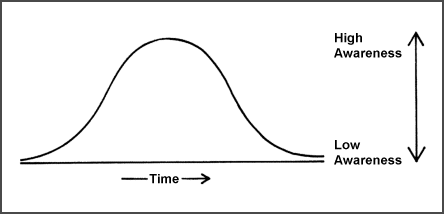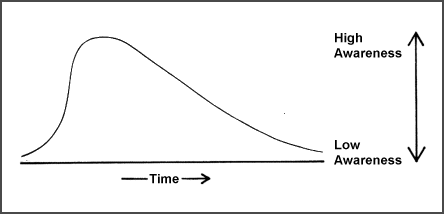Spring 1989 // Volume 27 // Number 1 // Forum // 1FRM1
They've Done It Again!
Abstract
Every five to ten years, Cooperative Extension introduces a new vocabulary. They've done it again! Recently, at both the state and national levels, Extension has initiated a new means of categorizing program efforts, using terms such as "initiatives" and "issues." Indeed, recent reports emphasize that "issues guide the system"1 and "issues are key."2 When confronted with this new vocabulary, Extension workers ask: Where do issues come from? Who discovers them? How do you know when you've found one?
Evolution of Issues
Instead of struggling with a definition of "issues," a more productive approach is to observe how they develop and emerge. Societal concerns (issues) typically have a pattern of development that's reasonably predictable and consistent. The issue often begins with low public awareness and then encounters increased public support over time (which might be precipitated by legal, social, or economic conditions).
Awareness, as presented here, refers to both the numbers of people who are now alert to the issue as well as the intensity of feeling (depth of concern) toward it expressed by those individuals. It then peaks in terms of public concern. This peaking may be brief or long lasting, depending on contextual factors. After the peak, a period of decline typically follows. Like the adoption curve, different people discover the issue at different times.
Various patterns of awareness and support are possible. Some issues can be characterized by the normal bell curve with the period of increased awareness matching the period of decreased interest (see Figure 1).

Figure 1. Matched periods of awareness.
Other variations are possible-a trigger event might prompt a period of rapid awareness followed by peaking and a slower decrease (see Figure 2). For example, suppose a well water testing program uncovers dangerous levels of contaminants and community interest is rapidly aroused.

Figure 2. Rapid awareness and slow decline.
In some situations, you might encounter a period of slow increases in awareness, peaking, and then more rapid decline. Figure 3 depicts situations where a technological solution has been developed after considerable research and the public assumes the problem has been solved. (It's interesting to speculate if the present concern about AIDS might reflect this pattern.) In still other situations, the peaking of public awareness might be long lasting as depicted in Figure 4. The slopes of increase and decrease will vary, as will the length of the peaking. The exact nature of the curve will be dictated by the situation, the solution, the nature of the response, and a host of environmental issues.

Figure 3. Slow awareness and rapid decline.

Figure 4. Sustained period of awareness.
Issues evolve in a predictable series of phases, beginning with identification, followed by confirmation, support, and finally, problem-solving alternatives.
Phase 1-Identification
Identification consists of observing, detecting a pattern, and attaching an appropriate label to a situation, phenomenon, or need.
Phase 2-Confirmation
Confirmation is essential to further progress. Confirmation consists of others (often professional colleagues) who corroborate the identification.
Phase 3-Support
Identification and confirmation are typically not sufficient to launch an issue into public prominence. Two forms of support are critical, and often intertwined, in the evolution of the issue: public support and fiscal support. Public support occurs when enough people place value on the resolution of the problem. Financial support is often needed to employ staff in conducting research to increase knowledge, marketing the issue to increase public attention, and piloting alternative solutions.
Phase 4-Problem-Solving Alternatives
The final phase in the evolution of an issue is the development of one or more alternatives that can address the problem. In Extension, this is an issue- developed program.
Features of Issue Evolution
Several features about the dynamic nature of issues can be discerned:
- Some people are able to identify the issue earlier than others. Community residents may see the problem, but fail to identify a trend. Regularly, but not exclusively, county agents and subject-matter experts take on this identification role. Someone must see a sufficient number of examples of the problem or need, effectively articulate the problem, and then seek confirmation of the interpretation. Progress may stop here unless the issue is confirmed, reinforced, or supported.
- The problem may not show up in needs assessment instruments until peak or post peak. Survey instruments that assess community needs and measure local opinion lag behind the actual need. An over-reliance on needs assessment procedures can place the organization in a situation where it reacts to public opinion too slowly and too late to have meaningful impact.
- Administrators of organizations and elected officials may not provide support until the concern reaches the peak. A considerable amount of risk exists for administrators or elected officials in investing scarce resources in program efforts that haven't yet met with public approval. It's unfortunate that early infusion of resources isn't readily available, because a small investment early in the development of the problem may save considerable resources later.
Implications for Extension Staff
Here are what I consider some major implications for Extension:
- Each staff member should examine his/her present programming efforts in light of the state and national issues. Efforts should be made to fit current programs into the issue and initiative categories. Issues make sense as a means of categorizing Extension's endeavors. One of the principal values of issues programming is that it has enabled us to cluster Extension efforts into categories that can be more effectively communicated.
- Extension staff should be alert to emerging issues on the local, state, or national level, and recognize the need for early identification and confirmation.
- Extension staff should be careful about the use of surveys and needs assessment procedures that tend to be reactive in ascertaining opinions, or that capture concerns only at the peak of public awareness.
- Extension staff at all levels should recognize the dynamic and developmental nature of issues. Program strategies will need to match the pattern of issue evolution.
The identified issues and initiatives don't represent the nation's pulse beat of need, but rather a strategic compromise between what's needed and what's possible within the constraints of current resources. In fact, this is a sophisticated and appropriate response in that it melds together needs and resources. Cooperative Extension can't, and won't ever be able to, meet all citizen needs, but it can meet certain needs within areas of expertise and resource capabilities. This is the strength of the existing attention to issues.
Footnotes
1. Extension Service, Cooperative Extension System National Initiatives: Focus on Issues (Washington, D.C.: USDA, January 1988).
2. Extension Committee on Organization and Policy, Extension in Transition: Bridging the Gap Between Vision and Reality (Blacksburg: Virginia Polytechnic Institute and State University, 1987).
